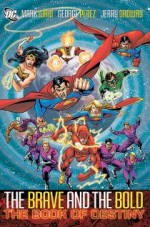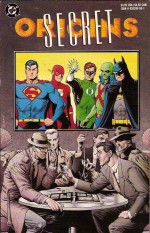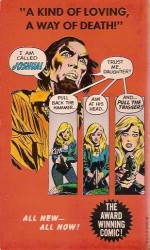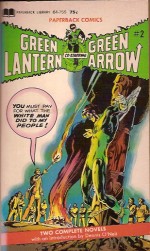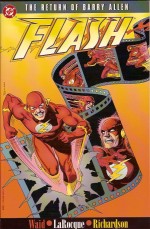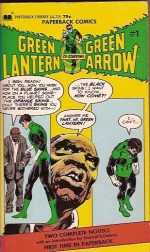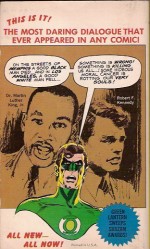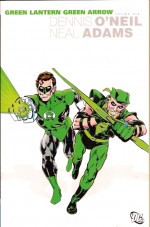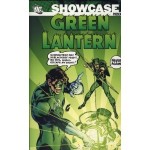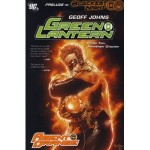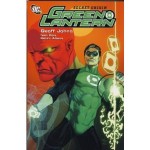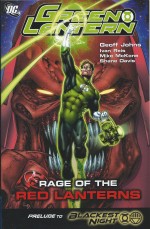
By Geoff Johns, Ivan Reis, Mike McKone, Shane Davis & various (DC Comics)
ISBN: 978-4012-2302-1
Since the dawn of the Silver Age of Comics where and when The Flash kick-started it all to become the fast-beating heart of the revived genre of superheroes, his fellow jet-age retread Green Lantern has always provided the conceptual core framework for the comprehensive, pervasive magic of the monolithic DC Universe’s shared continuity.
Hal Jordan was a young test pilot in California when an alien policeman crashed on Earth. Mortally wounded, Abin Sur commanded his Green Power-ring – a device fuelled by willpower which could materialise thoughts – to seek out a replacement ring-bearer, honest and without fear. Scanning the planet it selected Jordan and brought him to the crash-site. The dying alien bequeathed his ring, the lantern-shaped Battery of Power and his profession to the astonished Earthman.
Over the years Jordan became one of the greatest members of that serried band of law-enforcers, the Green Lantern Corps, which had protected the cosmos from evil for uncounted millennia under the auspices of immortal super-beings who dubbed themselves the Guardians of the Universe.
These undying patrons of Order were one of the first races in creation and currently dwell in sublime emotionless security on the world of Oa at the very centre of creation.
Even if you are a true Fights ‘n’ Tights epic aficionado, if all this is new to you then Rage of the Red Lanterns should absolutely not be your introduction to the series.
Go read (at least) Green Lantern: Secret Origin and preferably all the other collections of this monumental fixture in the comicbook firmament before attempting to decipher the compulsive, compelling, pell-mell onslaught of characters and concepts scripter Geoff Johns threw at the reader as his extended epic thoroughly reshaped that aforementioned DCU.
Still here? Okay then…
Following the bombastic, blockbusting Sinestro Corps War, all of creation was in turmoil at the revelation that Green was not the only colour and an entire emotional spectrum of unsuspected yet puissant energies underpinned and operated upon reality. In increasingly ambitious storylines, Johns began exploring the adherents and disciples of each hue and the forces transformed by or seeking to control them…a situation which would lead inexorably and inescapably into DC’s major crossover events Blackest Night and its sequel Brightest Day.
In themselves these twinned mega-sagas were the result of an increasingly all-encompassing series of comicbook crises which would dominate the company’s output for nearly three years…
This volume (collecting Green Lantern #26-28, 36-38 and the one-shot Final Crisis: Rage of the Red Lanterns #1) is billed as a “Prelude to Blackest Night†and its chronologically telescoped tales actually straddle the separately released Green Lantern: Secret Origins), so if you’re particularly wedded to strict running order that’s one more hurdle to your full enjoyment.
If you’ll permit an earnest aside: all this prevarication might seem like I’m trying to put readers off and don’t like the material I’m covering, but nothing could be further than the truth. When done right, these kinds of epic super-sagas are utterly mesmerising narrative intoxicants that no other medium of human expression can match, but very few of them can be enjoyed on purely ambient knowledge.
Almost anybody can come cold to Lord of the Rings, Gone With the Wind, Michener’s Centennial, Clavell’s Shogun or EE Smith’s Lensman books but still enjoy them with only the barest smattering of background and targeted exposition, whereas periodical comicbooks are more akin to long-running TV soaps like Coronation Street or Days of Our Lives, with neither time nor space to constantly reintroduce key characters, concepts and history, but still keenly dependent on specific knowledge to fully engage with the material.
I find it personally daunting and, after 30-plus years in the creative, educational and retail arenas of comics, know it is crucially off-putting for many potential newcomers and even old fans tempted to start reading their childhood favourites again. That’s just the way it is and why I’ll always go on about getting through this stuff in the most favourable order.
Here endeth the Sermon…
Written in entirety by Johns, the multi-hued madness here begins with a 3-part tale that originally appeared immediately after the conclusion of the Sinestro Corps War. ‘The Alpha Lanterns’, pencilled by Mike McKone with inks from Andy Lanning, Marlo Aquiza, Cam Smith, Mark Farmer & Norm Rapmund, detailed how cracks began to form in the solidarity of the Green Lantern Corps after the immortal, emotionally constricted Guardians began arbitrarily rewriting the ancient Laws in their biblical Book of Oa, such as no fraternisation between serving Lanterns and – crucially – revoking the Corps’ eons-old no deadly force mandate.
Moreover the little blue gods were clearly concealing important facts from their devoted peace-keeping force when they summarily created a harsh and draconian Internal Affairs division to police their police.
Worst of all, these new Alpha Lanterns had been surgically altered, becoming more slavish automaton than sentient sentinel…
Imprisoned in an Oan sciencell, rogue GL Sinestro of Korugar crowed over his ultimate victory. His army of monsters, armed with yellow rings fuelled by fear, had ravaged the universe and compelled the complacent, emotion-disdaining Guardians to panic and change their billion-year-old policies and edicts. He seemed utterly unmoved by the fact that his captors had retaliated by sentencing him to death…
The bubbling undercurrents of tense friction exploded when GL Laira took the new General Orders too far and executed a Yellow Lantern who had surrendered. She immediately fell under the remorseless jurisdiction of the Alphas, and her subsequent show trial and conviction further split the Corps. Galaxies away, the maimed Guardian dubbed “Scar†covertly seconded maverick GL Ash and dispatched him on a secret mission to recover the remains of universal nemesis the Anti-Monitor…
And on the devastated hell-world Ysmault – scene of the Guardians’ greatest shame – Atrocitus, one of only five survivors of his entire space sector, moved to create his own Corps of ring-bearers. These aggrieved agents would all be powered by the scarlet bile of red hot rage…
Battle lines were being drawn as the universe moved inexorably towards the fulfilment of an ancient dark prophecy.
Due to the Guardians’ ancient treaty with a deadly uncontrollable force wielding Orange light, the star-system of Vega had always been outside GL Corps’ jurisdiction, subsequently becoming an interstellar sinkhole and safe-haven for the very worst scum of universe.
Now, however, ancient racial offshoot The Controllers (a splinter group who split from the Guardians eons ago) entered the bewilderingly vast conflict, determined to appropriate the colour for their own arsenal, but tragically unaware of the horror they would unleash…
Convicted, stripped of rank and power but still unrepentant, furious Laira was being transported back to her home planet when a Red Lantern ring found her and completed her fall from grace…
‘Rage of the Red Lanterns Part 1’, illustrated by Shane Davis & Sandra Hope, then revealed the secrets of Atrocitus’ rise to power, expanded upon Ash’s quest for the husk of the Anti-Monitor and followed a doomed convoy of Green Lanterns tasked with transporting Sinestro to his place of execution on Korugar.
When they were ambushed by Red Lanterns determined to take the leader of the Yellow Lanterns to a far worse fate than death, all seemed lost until Hal Jordan was rescued by a benign saviour called Saint Walker who wore a ring of shining, cleansing Blue…
This wild spectacle continued in Green Lantern #36-38 with art from Ivan Reis, Oclair Albert & Julio Ferreira, as Jordan became focus and crucible of the conflict, with both Red Rage and Blue Hope attempting to possess him, making him their agent in a rapidly unfolding War of Light and horrific Darkest Night which would soon endanger all life and creation…
First, however, the conflicted earthman had to face Atrocitus and rescue Sinestro so that the renegade could be properly executed by the rightful authorities of the universe, even as on Earth his ex-girlfriend Carol Ferris was again targeted by the Violet light of Love and one of the coldly pious Guardians slipped further into black madness…
To Be So Very Continued…
Also featuring a beautiful and stirring gallery of covers by McKone, Lanning, Davis & Hope, this spectacular collection of plot threads and opening gambits combines all the signature big-picture theatrics, cosmic derring-do, tense suspense, solid characterization and blistering action fans adore, but even this “jumping on†epic is not really a beginning and far, far from a neat and tidy end.
So brush up on DC/Green Lantern history before even contemplating this astounding and ambitious first course in a banquet of comics indulgence…
© 2008, 2009 DC Comics. All rights reserved.

